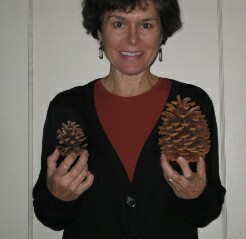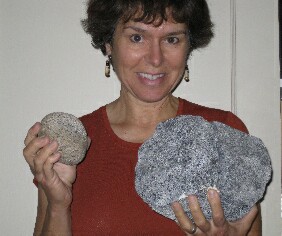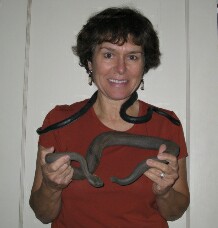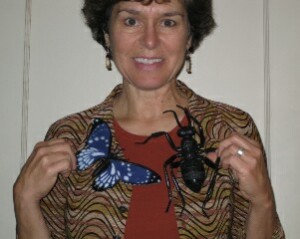A few years ago, author/illustrator Marianne Wallace had an assembly challenge. Like most authors who present in elementary schools, she would usually be placed in a large multipurpose room to do three assemblies for grades K-6. Audience sizes might range from 150 per session in small schools to 250-350 per session in the larger schools.
With nature the subject of her books, Marianne had gathered many life-sized props to illustrate her program. But she soon discovered that the kids in the back of the room could barely see them. So she decided to exaggerate the size of the props to dramatize her points, and suddenly her program popped into place.
Here’s Marianne Wallace herself to tell you (and show you) what she did.
This image shows an actual size tarantula and mega-sized one. In presentations, I show the smaller one against my hand for the actual size of some of the biggest of the real tarantulas and then I use the mega sized one to “illustrate” the rest of my talk.
I illustrated a book about the rock cycle and the large rock is made of painted foam rubber (latex wall paint and foam from an upholstery/ fabric store) and is the exact size of a real rock I got from the Sierra to do the illustrations in the book. But I tell the kids the actual big rock is too heavy to cart around (which it is). The smaller round granite rock is real and represents the rounder rock in the story.
The smaller rubber snake is a garter snake — great actual size, but too thin and small. The fatter, fake rattlesnake always works better and is a bonus since it is also actual size. Normally, I would wear a white or light plain blouse so the props would show up better.
I even have large bugs as props. I mean, an ant? Kinda hard to show one of those in actual size! But even with their large size, I think they’re too small for a cafeteria presentation so I rarely used them. Although I usually wear a white shirt to do presentations so my animal/plant props show up better, I thought I’d send this shot of the bugs against a print shirt. They’re often harder to see but in this case not so much for some reason.
 Both are pine cones, although from different species. I use the smaller pine cones for more intimate groups.
Both are pine cones, although from different species. I use the smaller pine cones for more intimate groups.
Also – I needed a hawk to explain how they swoop down on small prairie dogs. So I got a plastic hawk kite. It rolled up fairly small when not in use and was very lightweight. You can often find butterfly kites for sale, so there might be other animal kites as well that open up into huge props.
The problem with large props is primarily transporting them. I pile 3 plastic bins on a dolly when I do a full presentation. And since weight is a concern with natural objects, I favor plastic and stuffed animals. The plastic animals, which I got over a period of years, came from a variety of places such as Toys R Us, party stores, zoo or museum gift shops and Disneyland.
Thanks Marianne for these creative solutions to finding, making and sharing props with a multipurpose room audience!





Thanks for the demo, Marianne. You and Alexis make a good point about props being too small to see in large groups.
I use a Giant cheese and other large foods in one of my presentations and I swear I get more letters about my big cheese than anything else.
But I will keep this in mind when i am coming up with future presentations.
Big props to you!